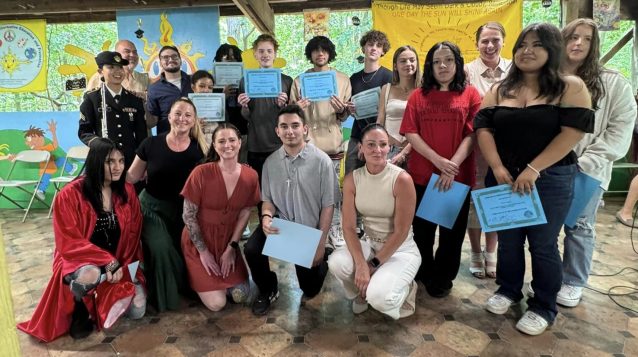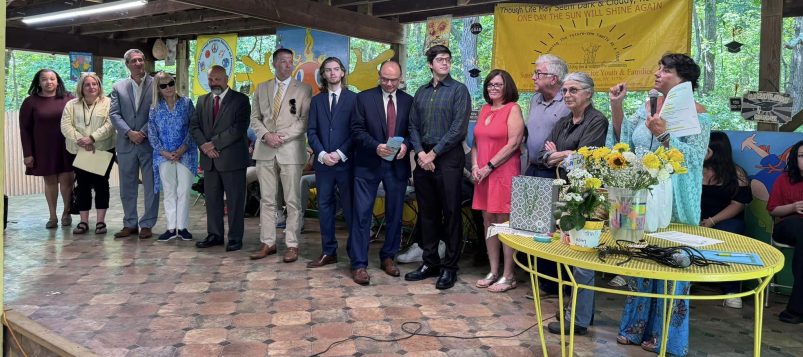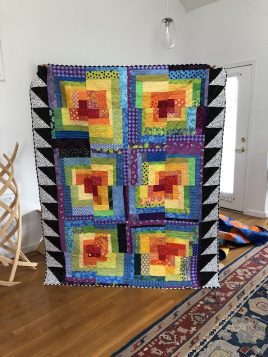By Donna Newman
Thirteen women gathered for a bittersweet luncheon in Stony Brook recently to celebrate more than two decades of collaboration that brought joy to many children and adults living in foster care or homeless shelters. They all expressed gratitude for the opportunity to participate in a worthwhile charitable endeavor, while realizing the time had come to move on. Bright Hopes was coming to an end.
Dating back to the early 2000s, the organization Bright Hopes, created by artist Deborah Fisher, had a heart-warming origin story, told in her own voice:
“When I was young my mother taught me to sew using her portable sewing machine. I sewed dolls, clothes, bags and watched my mother make quilts — planning, tracing, cutting — until something lovely emerged.
“In 2002 I spent three months doing an artist residency in Kohler, Wisconsin. I found myself in a strange town, in a strange house, with other artists I did not know. I had brought a handmade quilt with me, a gift from my husband’s aunt. The simple gesture of putting that quilt on the bed made it feel like home, which led me to wonder: What if we made quilts for people who had no permanent home? Maybe a bright, beautiful quilt could give them a piece of home, a sense of place, to carry with them wherever they went. I asked my mom if she’d like to make some quilts to donate, and she asked the very nicest people to join us, no sewing experience necessary. And with that, Bright Hopes was born.”
Suzan Goldhaber, in speaking about the birth, said there was no big plan in place at the start, other than a desire to improve the lives of homeless children.
“The development of Bright Hopes was organic,” Goldhaber said. “So many different, talented, generous people came together forming a camaraderie of sharing.”
In the beginning, there was Quilt GIVING, a program through which one-of-a-kind, handmade quilts were given to children living in foster homes and to families living in temporary shelters. These quilts were theirs to keep and take with them wherever they went.
Bright Hopes has donated more than a thousand quilts over the years, some directly to individuals, others gifted with the help of regional agencies.
Judy Albano described an experience that formed her first real understanding of the value of Bright Hopes. She said she rode along during a quilt delivery to mind another volunteer’s baby. Upon arrival, the driver took the quilts inside. After a time, she wondered what was taking so long, so she took the baby and approached the door.
“Just then, three joyful girls ran out, each wrapped in a colorful quilt, despite stifling summer heat,” Albano said. “Their delight was amazing.”
The next step for Bright Hopes followed the realization that if simply providing a quilt can foster hope for someone, what would happen when that person learns quilt-making skills and the ability to create quilts themselves?
Beginning in the autumn of 2009, a new program called Quilt WORKS was initiated at Little Flower Children’s Residence in Wading River. Once a week, volunteers bearing sewing machines met with children (aged 8 to 19) to teach them how to use a sewing machine and the basics of quilt-making. A field trip to a fabric store let the kids choose fabric for their quilt. Each child was helped to assemble the top of a quilt, which was backed and finished by Bright Hopes volunteers, then returned to the maker to keep and enjoy.
Many volunteers came and went over the program’s 10 years, Deborah Fisher said, but the commitment of a few consistent regulars made the program possible. They were Joyce Bonitch, Clione Stancik and Ronni Camhi, who played a huge role at Little Flower before she moved away a few years ago.
“My time working with Bright Hopes introduced me to a group of amazing, committed women and gave me a very longed for sense of community, both with these women and with the community at large,” Camhi said. “I was able to give back and help many people. I grew as an individual as well as improving my creative sewing skills. It’s what I miss most about leaving New York.”
In the words of Joyce Bonitch, “To see the smiles on their faces when the quilts were done was wonderful. A few returned to make another quilt for a family member or friend. One girl made a quilt for a Little Flower staff member. There was a time we were able to visit a cabin and saw the quilts on the kids’ beds; bright colors added something special to the space.”
The next logical progression was Quilt COMMUNITY. Carole-Ann Gordon, employed by FREE (Family Residences and Essential Enterprises) and a group member, made a proposal. After receiving training at FREE’s Day Services East, their differently abled adults began sewing quilts to be donated via Quilt GIVING — a win for both creators and recipients.
Bright Hopes eventually joined with Suffolk County community groups to teach sewing skills and increase the number of volunteers making quilts for donation.
Before the luncheon ended, I asked the women seated around the kitchen table what they felt was the very best part of Bright Hopes. Without a moment’s hesitation, Suzan Goldhaber answered, “Each other!” And those words echoed around the room in unanimous agreement.
Over time, women joined the Bright Hopes family in different ways. One woman began quilting after her adult son took it up as a hobby. “I was inspired by Deb’s books about quilting,” Helen Emmerich said, “and when I learned about Bright Hopes, I was in.” Dorothy Cardi found the Bright Hopes booth at Gallery North’s annual Outdoor Art Show and Music Festival and was inspired. Sandy Miller was an editor at Newsday when a 2004 article about Bright Hopes caught her attention. “I clipped the article and saved it,” said Miller, “thinking when I retire, I’ll have time for this.” Years later, she did.
Deborah Fisher summed up the years saying she felt honored to get to know all the compassionate and caring volunteers who were involved. They became a family and had been through a lot together.
“I am grateful to have had the opportunity to bring together an amazing group of women who have taught me so much,” she said.






































